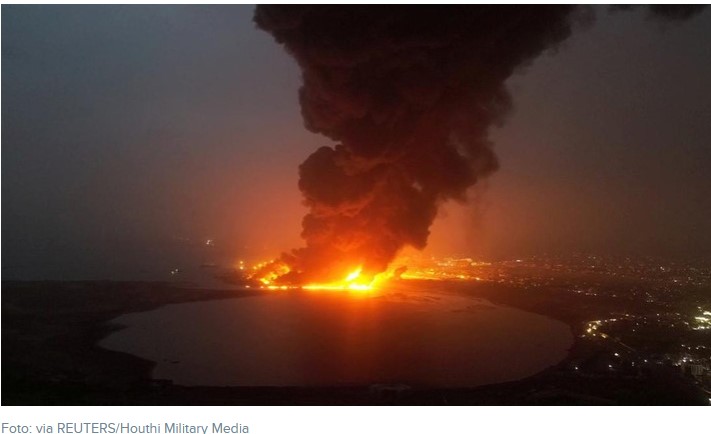
The foto has taken from Youtube
STRATEGIC ASSESSMENT. Iran finally launched its long-awaited response to Israel’s targeting of high-ranking Islamic Revolutionary Guard Corps – Quds Force (IRGC-QF) members on April 1 at Iran’s consulate in Damascus, Syria. The Iranian attack unfolded over several hours and included approximately 185 drones, 36 cruise missiles, and 110 surface-to-surface missiles. Iran used the Shahed-136 kamikaze drone and some Shahed-238 drones in the attack. Drone swarms and missile barrages are asymmetric means of competing with the technological superiority of Israel and its allies. Most of the missiles were fired from Iranian territory, although some were fired from Iraq and Yemen. Lebanese Hezbollah also fired rockets at IDF barracks in the Golan Heights, although Hezbollah claimed that this operation was unrelated to Iran’s attack on Israel.
Even as the Israelis are claiming that the drone and missile barrage caused limited damage, Iran has attempted to redraw regional red lines and make it clear that if Israel attacks Iranian territory, Tehran will retaliate not only through its proxy network but also from Iranian soil, pushing the conflict out of the shadows and into a dangerous new phase. Israel has declared that most drones and missiles were shot down. This was due, at least in part, to the robust involvement of the U.S., UK, and other coalition partners, who were integral to Israel’s success in blunting the attack, forming a multi-layered defense. Nevertheless, the Israelis admitted that the attack was far more complex than expected.
The purpose of the drones, or unmanned aerial systems (UAS), was to inundate Israel’s robust air defense systems, not just the Iron Dome, but jet fighters, David’s Sling, the Arrow system, and other redundant layers constructed to prevent attacks by missiles and drones. The anatomy of the attack indicates that Iran attempted to overwhelm the Israeli defense system to be able to hit the intended targets. Most of the drones and missiles were intercepted, although Israel claims that one of its military bases suffered minor damage. The U.S. military successfully intercepted many of the Iranian drones and missiles over Syria, especially in Dera’a and As-Suwayda. Other Western allies also played an important role. According to a statement released by the Israel Defense Forces (IDF), “Individual injuries were detected, among them at a military base in the south of the country with minor damage to the infrastructure.” According to ABC News, five ballistic missiles hit the Nevatim Air Base, damaging a C-130 transport aircraft, an unused runway and empty storage facilities, while four additional ballistic missiles hit the Negev Air Base. Still, more than half of the ballistic missiles fired by Iran either failed to launch or crashed before reaching their intended target, according to the Wall Street Journal.
An Iranian response had been anticipated, and several countries in the region, including Lebanon, Iraq, and Jordan, had all closed their airspace. Numerous European countries previously ceased flights to the area. Given the lead time up until the attack, intensive shuttle diplomacy by all sides involved was taking place behind the scenes, with Iranian diplomats backchanneling—not to contain the attack but its aftermath and Israel’s expected response. Iran claimed their targets remained relegated to military targets in the Golan Heights and an Israeli Air Force base in the Negev Desert. Both targets are believed by the Iranians to be related to Israel’s early April strike in Damascus.
The Iranian drone and missile attack on Israel carries several implications and conclusions. The attack was defeated by a significant coalition that, together, formed a layered defense stretching from Iran’s borders through to Israeli airspace. A large proportion of the barrage was intercepted before it reached Israel. Iran might have established a measure of deterrence against Israeli strikes on the Iranian territory. From its inception, Tehran has made it a point to stress that this was a “defensive” attack in retaliation to Israel’s April 1 strike on its consulate in Syria. Tehran felt it had to cause Israel to think twice about carrying out more strikes at will with no fear of retaliation. To this extent, Iran did accomplish at least some of its objectives for the attack.
On Saturday evening (morning time in Iran), Tehran signaled that the attack was over, sending a post from the X (formerly Twitter) account of Iran’s Permanent Mission to the United Nations that read: “Conducted on the strength of Article 51 of the UN Charter pertaining to legitimate defense, Iran’s military action was in response to the Zionist regime’s aggression against our diplomatic premises in Damascus. The matter can be deemed concluded…” However, Saturday night’s attack may not end Iran’s response. Tehran might move forward with deniable terrorist attacks on Israeli facilities or citizens abroad. Iran may have also overestimated differences between the U.S. and its European allies, on the one hand, and Israel, on the other, over the situation in Gaza. Some analysts believe that Iran failed to anticipate the extent to which Washington and the Europeans would help Israel defend itself against the barrage. Iran’s attack will likely revive suspicions and animosity for Tehran among the Arab monarchy states of the Persian Gulf. Saudi Arabia and the United Arab Emirates (UAE) might rethink their rapprochement with Tehran because Iran is attempting to redraw red lines in the region, especially with its direct attack on Israeli soil from Iranian soil.
Even with a limited target set, the chances of miscalculation were high, and the attack was risky. A major current unknown is the U.S. response and the possibility that this could significantly ratchet up tensions further, dragging the region closer to all-out conflict. Since Jordan assisted in shooting down drones, there are growing concerns that Amman could also be pulled further into the conflict. The situation on the ground remains fluid, and it is worth reiterating the potential for miscommunication or a misinterpretation of the red lines involved. Against highly advanced Western and Israeli systems, Iranian technology fared poorly. The Iran regime hardliners likely felt that there were no other options but to respond. Some believe that the Iranians expected most of the drones and missiles to be intercepted. If they had penetrated Israeli and allied missile defenses, the attack would have been far more severe, and accordingly, so would the Israeli response to Iran. If Israel and its allies had not been afforded a week to prepare its defenses, it remains uncertain how many of the drones and missiles would have been intercepted. The long lead time and advanced notice of an attack were intended, at least in part, to reset the rules of engagement.
Iran limited the involvement of its proxies to send a message expanding the rules of engagement with Israel that if Iranian sovereignty is violated, Iran will respond directly against Israel from Iranian territory, even if it means crossing Israeli redlines. Still, the second-order effects could involve escalation between Israel and one or multiple Iranian proxies in the region. The Biden administration has been trying to stall an Israeli counterattack. According to Ronen Bergman in the New York Times, an Israeli retaliatory strike was called off after Netanyahu spoke with Biden on the phone late Saturday. Washington will continue to work on calibrating Israel’s response in a way that maintains Israeli deterrence while limiting the potential of expanding the conflict.
The attacks on Saturday could end up being one of the rare occasions where each side gets to claim victory. The lack of effectiveness of Iran’s missiles and drones is a win for the Israelis. That Israel needed several coalition partners to defend it will be touted as a win by the Iranians, who will also boast about their willingness to cross Israel’s red lines to clarify the rules of engagement. Each side will find a way to look at this as a success. The Biden administration, for its part, will get to say that it stood by its word in defending Israel, aligning with other allies to minimize the impact of the attack, and coming to Israel’s aid during a time of need. On balance, the Biden administration’s response was largely successful, defending Israel while also forestalling a further Israeli attack that has the potential to plunge the region into further chaos. However, the administration has also clarified that it will not allow Netanyahu to drag the United States into a regional conflict, at least any more than Washington is already involved (TSC).





